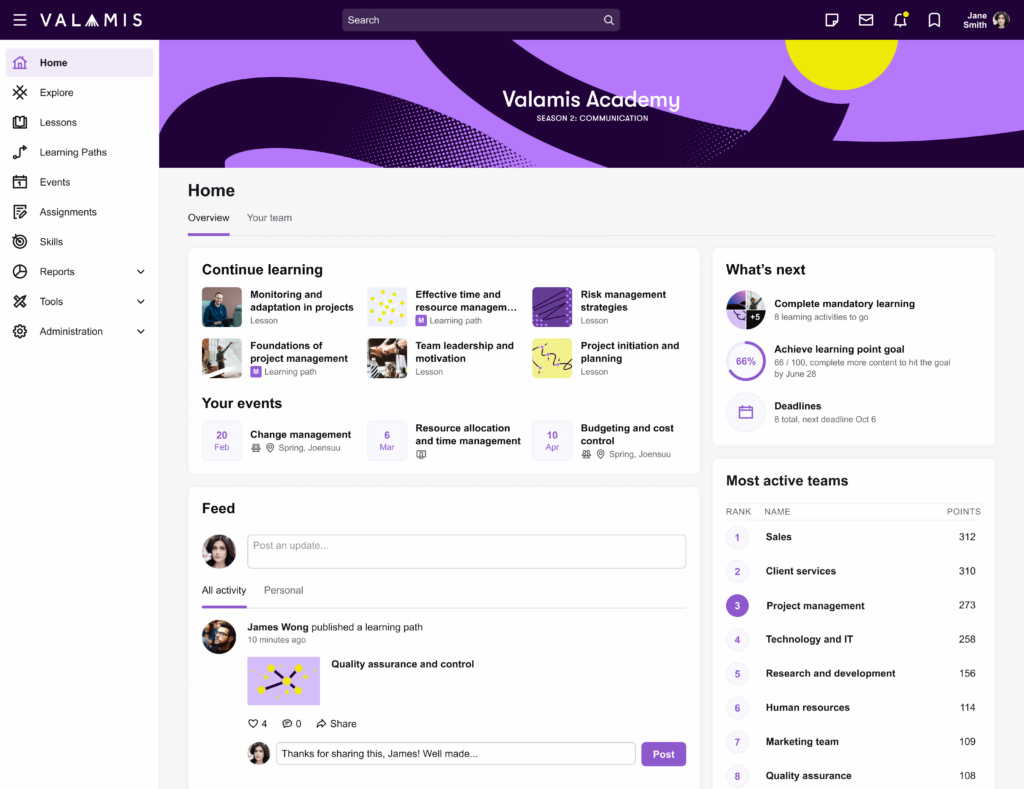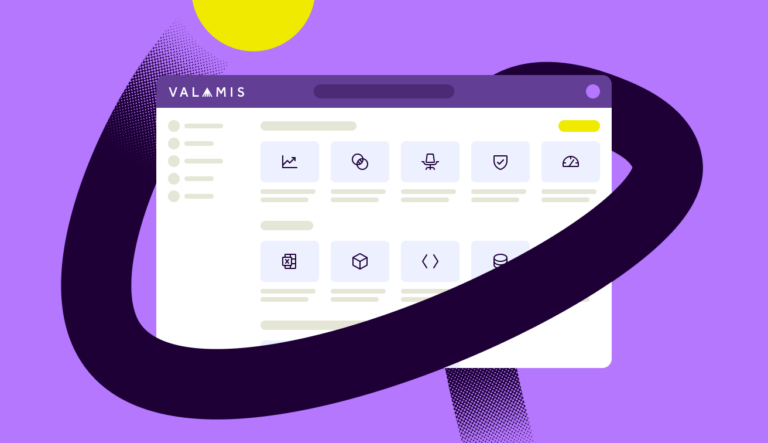Develop an effective employee training program
Find out how to improve employee training and use best practices to set your organization up for success.

Employee training is one of the most important parts of developing a thriving workforce.
Without consistent and thoughtfully designed training, employees stagnate, productivity lags, and the organization risks falling behind in an increasingly competitive marketplace.
This article will walk you through how to create an effective employee training program that actually works. You’ll learn what employee training is, why it matters more than ever in 2025, and how to design training experiences that build real skills, boost performance, and support long-term development.
Contents:
- What is employee training?
- Why employee training is important in 2025
- What types of employee training and development programs exist?
- How to build employee training and development programs
- What are examples of effective employee training methods?
What is employee training?
Employee training a structured program aimed at enhancing the knowledge, skills, and competencies of employees, enabling them to perform their roles more efficiently and prepare for future responsibilities.
This training can be role-specific, compliance-based, or focus on broader professional development goals.
Today, employee training is more than a “nice to have.” It is a strategic investment in an organization’s most valuable asset: its people.
Why employee training is important in 2025
In 2025, the world of work is defined by rapid technological advancements, hybrid work environments, and ever-changing market demands.
Without robust training, employees are left struggling to keep up.

L&D strategy framework
You will receive a list of questions along with a spreadsheet template to help you analyse your L&D strategy.
DOWNLOAD FRAMEWORKResearch highlights the urgency:
- A LinkedIn Learning report states that 94% of employees say they would stay at a company longer if it invested in their learning and development.
- Research consistently shows that companies that invest in strong employee training programs tend to outperform competitors — not just in engagement, but in long-term profitability too.
- McKinsey found that companies focusing on continuous upskilling are 2.5 times more likely to outperform competitors.
In short: Investing in employee training isn’t optional. It’s survival.
What types of employee training and development programs exist?
Before we dive into building your dream program, let’s talk about the different flavors of employee training.
Think of it like a menu — different options depending on what your team needs most, whether you’re building a corporate training strategy for the whole organization or targeting specific skills.
Employee training program means a planned series of educational activities designed to equip employees with specific skills or knowledge. Programs can vary based on goals, industries, and workforce needs.
Here’s a quick rundown:
- Onboarding training – perfect for welcoming new hires and getting them up to speed with company culture, policies, and role-specific duties.
- Compliance training – no one loves it, but it’s absolutely necessary to meet legal and industry regulations.
- Technical skills development – if employees need to sharpen their hard skills, this is the way to go. (Also includes upskilling and reskilling!)
- Soft skills training – communication, leadership, emotional intelligence — all the “human” skills that tech can’t replace.
- Product training – crucial if you roll out new products or services.
- Leadership development – spotting future leaders early can make a massive difference.
- Cross-training – want a team that’s flexible and resilient? Teach them skills outside their core job descriptions.
- Reskilling and upskilling– for employees transitioning into new roles or adapting to technological changes.
- Diversity & inclusion training – building a more inclusive and respectful workplace.
- Resilience training – helping employees manage stress, adapt to change, and bounce back from setbacks.
- Cybersecurity training – equipping employees to recognize and avoid cyber threats.
How to build employee training and development programs
Okay, now the exciting part — actually building your employee training program! Here’s a step-by-step guide:
Identify training needs
Your training program should start with a strong foundation: understanding what your employees actually need. Skipping this step can lead to wasted time, money, and energy.
Use tools like surveys, performance reviews, and one-on-one interviews to identify current skills gaps and future skill demands. Pay close attention to both individual and organizational goals.
Pro tip: Don’t assume you know what your employees need. Ask them! You’ll often uncover blind spots that can reshape your approach.
And if you’re already using a learning platform to support your team, chances are you have some of this data at your fingertips.
Many companies find that their LMS quietly collects valuable insights about learner engagement and performance trends — a great place to start spotting patterns.
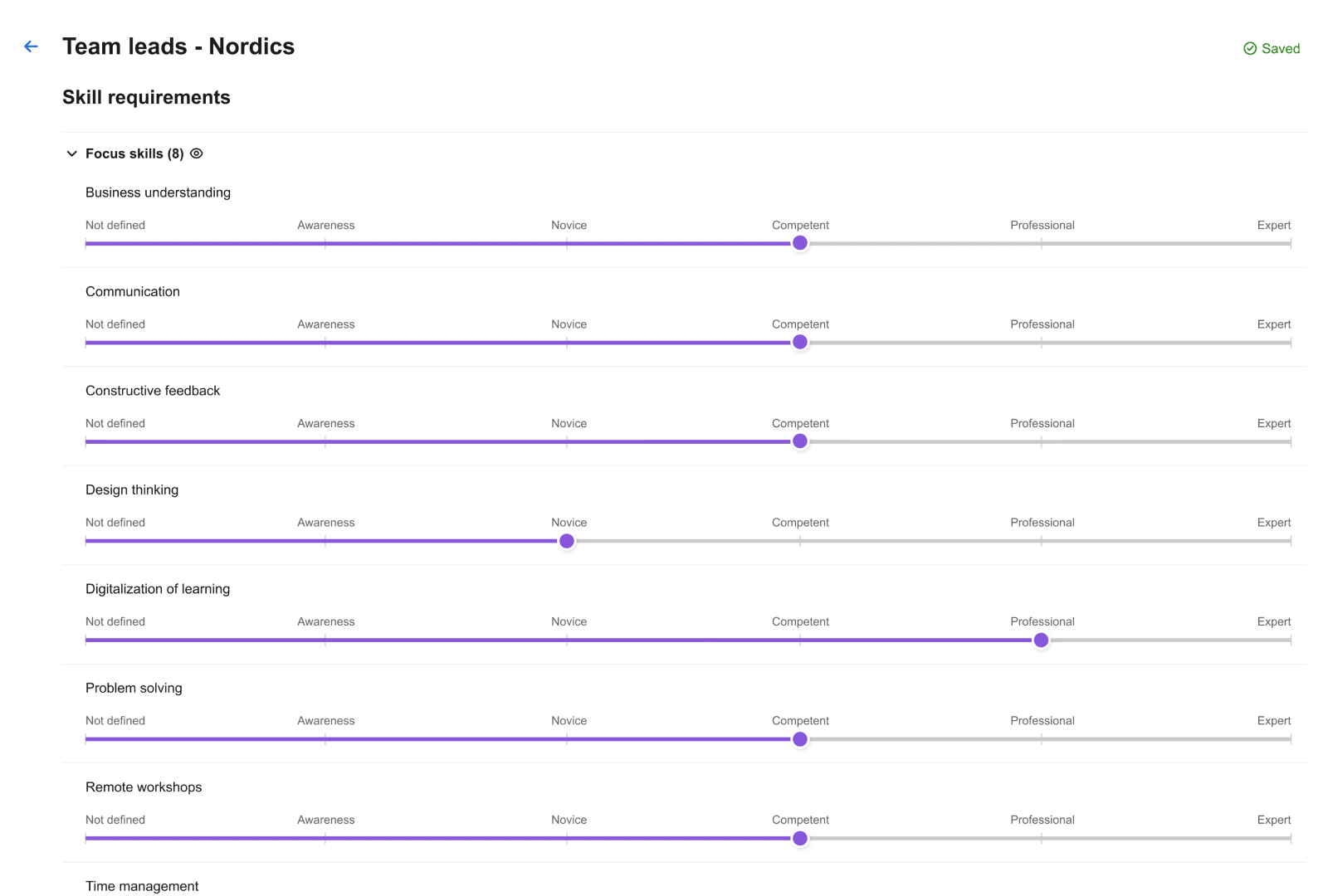
Valamis platform dashboard showing team skill requirements to help define employee training goals and program focus areas.
Define clear objectives
Once you know what needs to be addressed, outline what success looks like.
- What do you want employees to walk away with after completing the training?
- Are you aiming to speed up onboarding, reduce errors, or improve customer satisfaction?
Set SMART goals (Specific, Measurable, Achievable, Relevant, and Time-bound) for clarity and accountability. These will serve as your roadmap when selecting content and evaluating outcomes.
This is also the stage where digital tools shine — platforms like an LMS help ensure that goals aren’t just discussed, but actually embedded in the design of every course, tracked along the way, and revisited through learner progress.
Choose the right training methods
Now comes the fun part — selecting how you’ll deliver the training.
From interactive eLearning to job shadowing and peer mentoring, you have plenty of options (see more methods below in this blog).
But don’t just pick what’s trendy. Consider your audience: Are they remote or on-site? Experienced or just getting started? Visual learners or hands-on types?
Blend whenever possible. A good mix of methods keeps engagement high and supports different learning preferences.
Develop engaging content
If your training feels like a chore, it won’t stick.
So focus on making it engaging, digestible, and actionable.
Break content into modules or microlearning moments. Use real-life scenarios to make lessons practical.
Add quizzes or quick challenges to reinforce knowledge.
Pro tip: Keep things interactive. Static PDFs or long lectures will drain attention fast. Use visuals, video, and storytelling whenever possible.
Whether you’re creating content in-house or curating from external sources, a well-designed learning platform can help.
With built-in authoring tools, content libraries, and learner feedback loops, you’re better equipped to build content that doesn’t just inform but inspires.
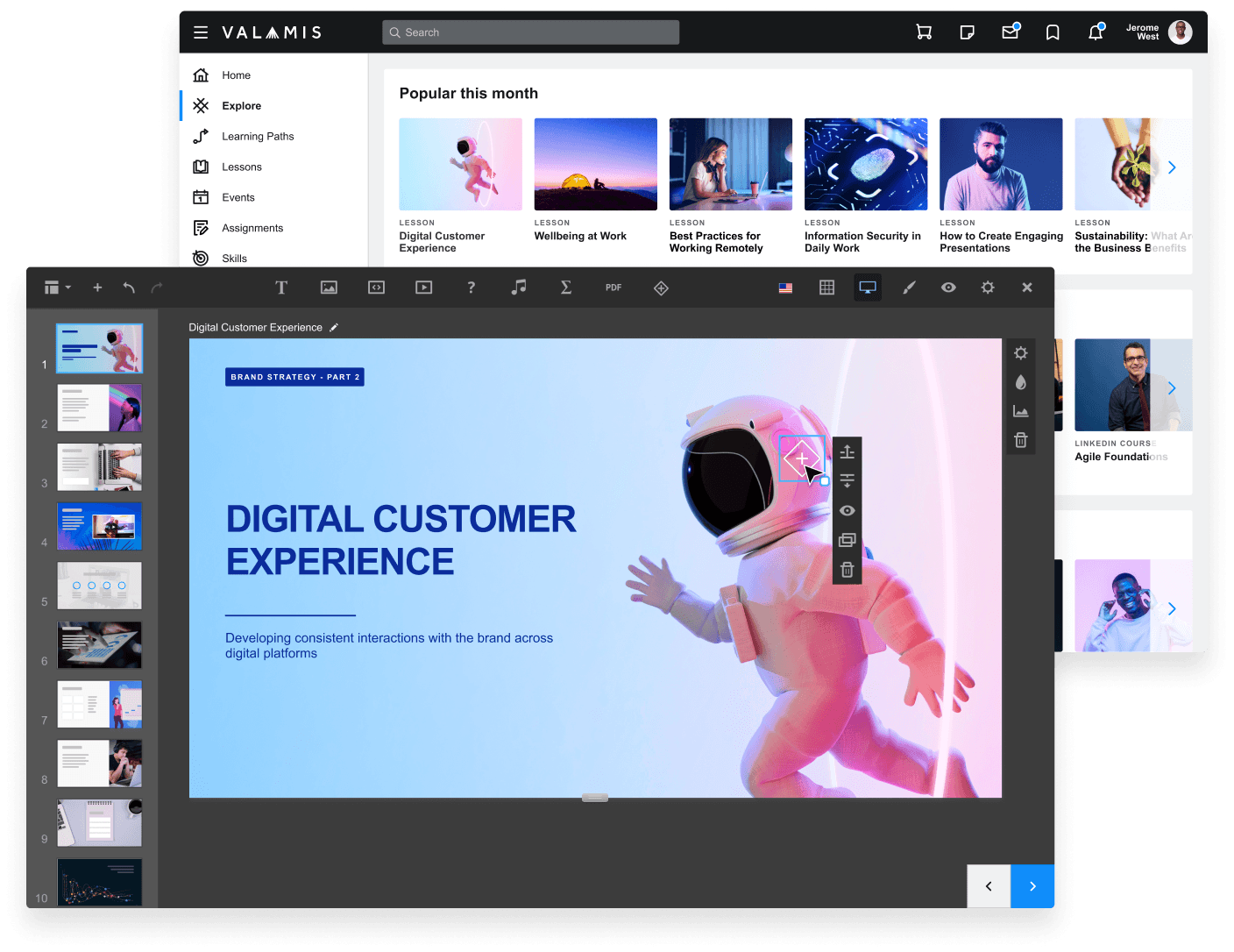
Screenshot of Valamis Lesson Studio and Content authoring tool showing content creation tools for building employee training lessons.
Read: Complete learning solution: 8 benefits of having an all-in-one platform
Implement and communicate
Rolling out a training program requires more than just sending a few email reminders.
Make sure everyone involved understands why this training matters and how to access it.
Get buy-in from leadership and share success stories to build excitement. Also, make time for training in the workday—don’t expect employees to learn “on their own time.”
Tip: Launch with a bang. Host a kickoff webinar or create a teaser video to spark interest.
Measure and improve
Finally, always measure results and ask for feedback. Use that info to tweak and improve your program over time.
Remember: great training evolves!
While every company needs a training program, it does little good if the program isn’t very effective.
One of the hardest parts of evaluating your training program is figuring out how you’ll objectively assess the training to see if it’s truly working.
This is where learning analytics becomes incredibly valuable. Essentially, learning analytics involves collecting data about learning behaviors, analyzing it, and creating actionable insights that help you enhance the learning experience.
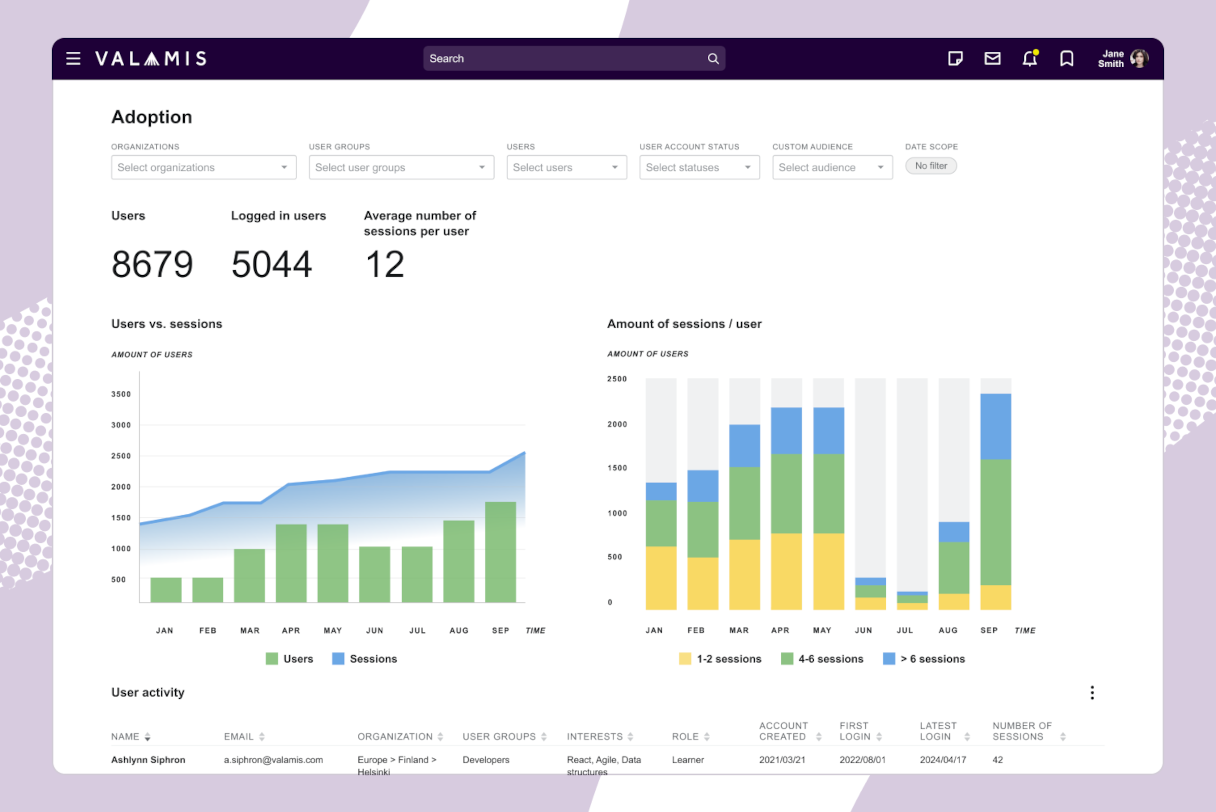
If you want to dive deeper, check out our guide on how to measure and evaluate training effectiveness to build a results-driven training strategy that truly impacts your business outcomes.
When this data is housed in one central platform, you’re not just gathering metrics — you’re gaining a strategic lens into your workforce’s growth. A thoughtfully used LMS can quietly become your best partner in continuous improvement.
See how Valamis brings everything you need for learning and development into one intuitive platform.

L&D strategy framework
You will receive a list of questions along with a spreadsheet template to help you analyse your L&D strategy.
DOWNLOAD FRAMEWORKWhat are examples of effective employee training methods?
Here are a few training methods you might want to mix and match:
- eLearning modules – perfect for remote and hybrid teams who want to learn at their own pace.
- Instructor-led workshops – still king for collaborative, discussion-based learning.
- Microlearning – short, digestible lessons that respect your employees’ busy schedules.
- Mentorship programs – pairing newer employees with seasoned mentors can fast-track growth.
- Simulations and role-playing – great for practicing real-world scenarios in a safe environment.
- Social learning platforms – let employees learn from each other with forums, chats, and shared resources.
How Valamis can help you with employee training & development
Still with us? Nice — we know this was a lot to take in. But if you’re sitting there thinking, “Okay, this all sounds great… now how do I actually make it happen?” — you’re not alone.
That’s exactly what we built Valamis for.
It’s a learning platform designed to take the stress out of training and development. You don’t need a team of data scientists or instructional designers — just a place to build great learning, track progress, and keep things moving. See what is inside -> here.
Whether you’re starting from scratch or just want to make your current setup a little smoother, Valamis is here to help. One platform, everything in one place, and people who get what you’re trying to do.
Curious to see it in action? Reach out to our team — we’d love to chat.
